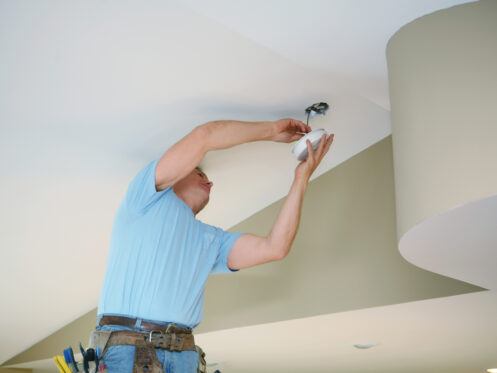Winter in Denver, CO, can be brutal. With extremely low temperatures for a large portion of the season, you can’t expect to stay warm without a functional furnace. With natural gas heating a top choice in the region, it’s important to have a solid plan for preventing house fires and carbon monoxide (CO) exposure. The following are several safety tips to help get you started.
Schedule Annual Furnace Maintenance
Always have your fuel-combusting furnace professionally inspected and maintained before the start of the heating season. By catching and correcting minor issues, our technicians can help you avoid a heating emergency. We change out worn components and remove debris from pilot lights, ignition switches, thermocouples, and air intake valves. We also inspect all electrical connections, gas lines, and exhaust systems. Together, these measures promote safe and reliable furnace operation.
Have Your Water Heater Inspected and Maintained
If you use a natural gas furnace, there’s a good chance that you use a gas-fired water heater. The winter is the perfect time to have this appliance professionally maintained. We’ll inspect your water heater’s venting system and the integrity of the tank. We’ll also replace the anode rod and check for gas leaks.
Check Your Furnace Flame When Inspecting Your Furnace Filter
You should inspect your furnace filter monthly and change it every 30 to 90 days. Keeping a clean furnace filter installed will prevent airflow problems, overheating, short cycling, and more.
If you have an older gas furnace with a pilot light, take a minute to inspect the color of its flames. Your furnace’s pilot light and burner flames should always be bright blue. If they’re ever yellow, orange, or red, your furnace is burning gas incompletely and needs immediate service.
Have Your Home Envelope Assessed
With a tight home envelope, your heater won’t have to burn as much fuel to keep everyone warm. However, whenever there are fuel-combusting appliances in the building, it’s important to avoid making your envelope too tight. Doing so could lead to dangerous backdrafts. Backdrafting occurs when negative air pressure pulls carbon monoxide and other exhaust gases back into the building. When adding insulation and making other efficiency upgrades, take steps to increase or improve your home’s natural ventilation.
Keep Flammable Items Away from HVAC Air Vents and Registers
Keep items like blankets, curtains, furnishings, and clothing away from HVAC air registers, vents, and grilles. This will minimize the risk of fires and ensure even air distribution.
Don’t Use Any Portable, Fuel-Burning Equipment Indoors
Never use portable, fuel-burning appliances inside of a building, such as a portable generator. Anything that burns fuel should either be used outside or attached to a code-compliant venting system. If the power goes out and you have no other means for cooking, munch on sandwiches, pantry items, and other ready-made goods.
Have a Secondary Heating Plan for Power Outages
It’s important to have an alternative strategy for heating your home or powering your furnace during outages. If you have a fireplace or a properly vented, wood-burning stove, you can always stock up on firewood and use it in a pinch. However, having a standby generator installed will both keep your heater working and meet all of your other electricity needs. It will also limit the temptation to fire up fuel-burning appliances indoors.
Replace Your Gas-Fired Furnace If It Still Has a Pilot Light
Natural gas furnaces with pilot lights haven’t been manufactured since 2010. Given that most of these appliances last just 15 years, now is a good time to schedule a replacement. Not only will a new furnace offer better and more efficient performance, but it will also come with a new heat exchanger and fuel combustion chamber for a far lower likelihood of gas leaks.
Have Your Carbon Monoxide Detectors Tested and Replace Their Batteries
CO gas is both odorless and colorless. It can enter your home and permeate every corner of your living environment without you being aware of the situation. When using fuel-burning equipment, having functional CO alarms will keep everyone protected.
You should test your CO alarms monthly. If these devices operate solely on batteries, be sure to replace them every six months.
Your Smoke Detectors Require Regular Testing and Battery Replacements Too
Test your smoke detectors and optimize their locations. If wall-mounted, these devices should always be at least four to 12 inches away from your ceiling. They should also be sufficiently far away from windows, doors, vents, and other sources of drafts.
For assured safety, you should test your smoke detectors monthly. These devices require new batteries every six to 12 months. Using high-quality batteries will allow for longer lifespans, less maintenance, and more reliable performance overall.
How to Handle Hard-Wired Combination Detectors
Many modern homes have hard wired combination smoke and CO detectors. Also known as combination detectors, these units use the home’s main power supply. However, if your power ever goes out, combination detectors also have backup batteries to keep them running. These units should be tested annually during your yearly furnace tune-up. Even though backup batteries are recharged by your electrical system, they should still be replaced every six months.
Keep Your Roof and the Perimeter of the Building Clear
Your fuel-burning appliances are vented outdoors. If the exhaust vents that carry toxic gases are ever blocked, carbon monoxide and other gases could make their way back into the building.
If you don’t have a shed for tools, bicycles, summer tires, and other items, you may be tempted to prop them against the side of your home. It’s far better to store these items in your garage. You should also regularly shovel the areas around low-sitting exhaust vents and keep your rooftop clean. Heavy snow loads and other organic buildups can block these features.
Trim Your Trees
Trimming back your trees before winter arrives is key to protecting the integrity of your exhaust vents. Having weak or dying branches fall off during times of heavy wind could crush these features or block exhaust.
Never Use Portable Heaters as Long-Term or Whole-House Heating Solutions
Portable heaters aren’t safe for long-term use and they aren’t effective whole-house heating solutions. Although there are many modern options with cutting-edge safety features, anti-tip designs, and smart temperature control, leaving these models unattended can lead to devastating house fires.
While portable heaters are cheap to acquire, they’re also expensive to use. This is especially true when using them as long-term replacements for a furnace, heat pump, or boiler. Space heaters can’t heat more than one room at a time, and most residential electrical systems can’t support the simultaneous use of multiple space heaters.
If you have a low-performing or non-functioning furnace, make replacing this appliance your top priority. Even with space heaters, if you lack a fixed, whole-house heating solution, it’s possible to have a heating emergency.
We’re committed to helping residents of Denver, CO, stay comfortable and safe. We offer first-rate heating, cooling, plumbing, and electrical services. We also provide indoor air quality improvements and preventative maintenance plans. To schedule annual furnace or water heater maintenance, contact Specialty Heating & Cooling LLC today.

